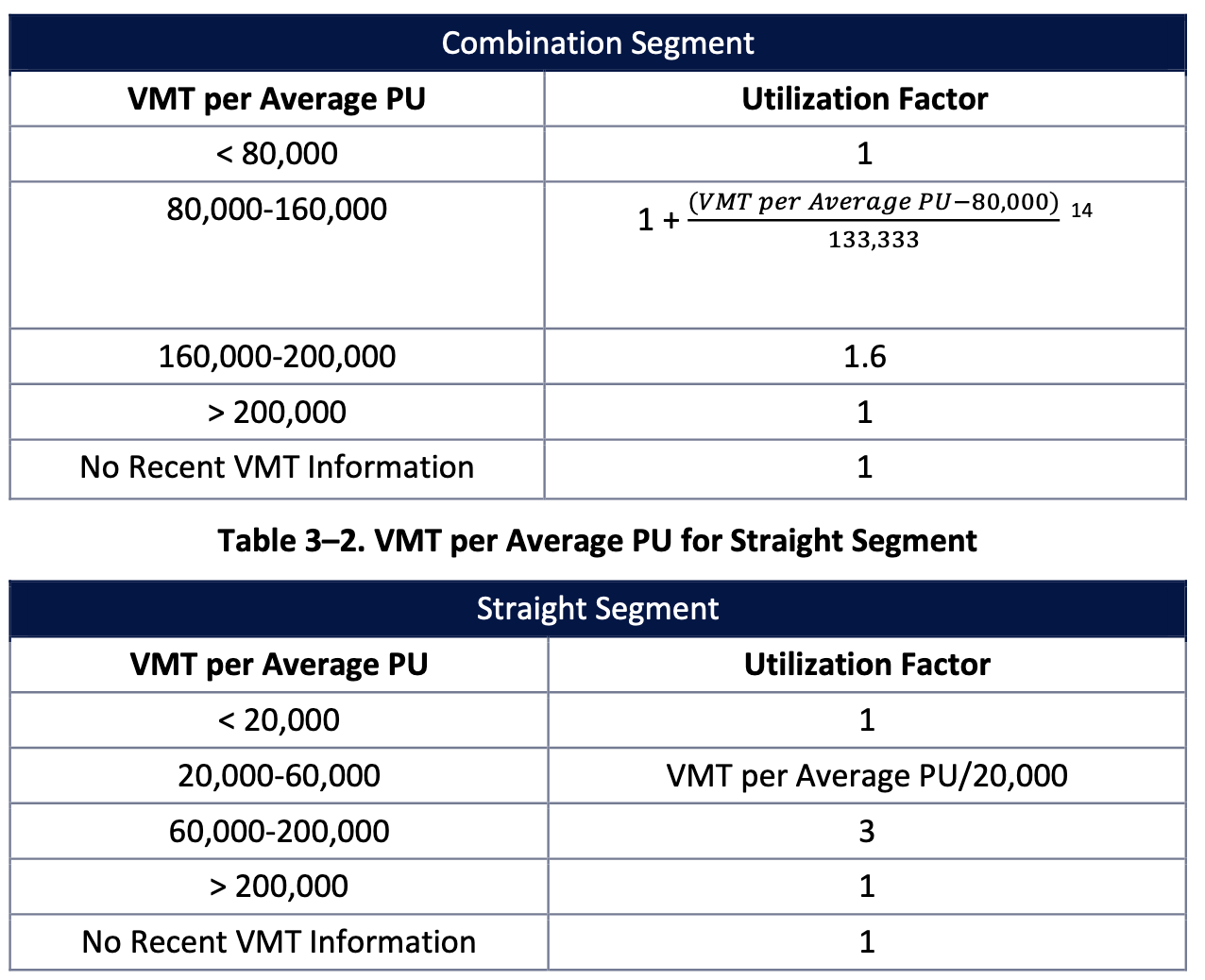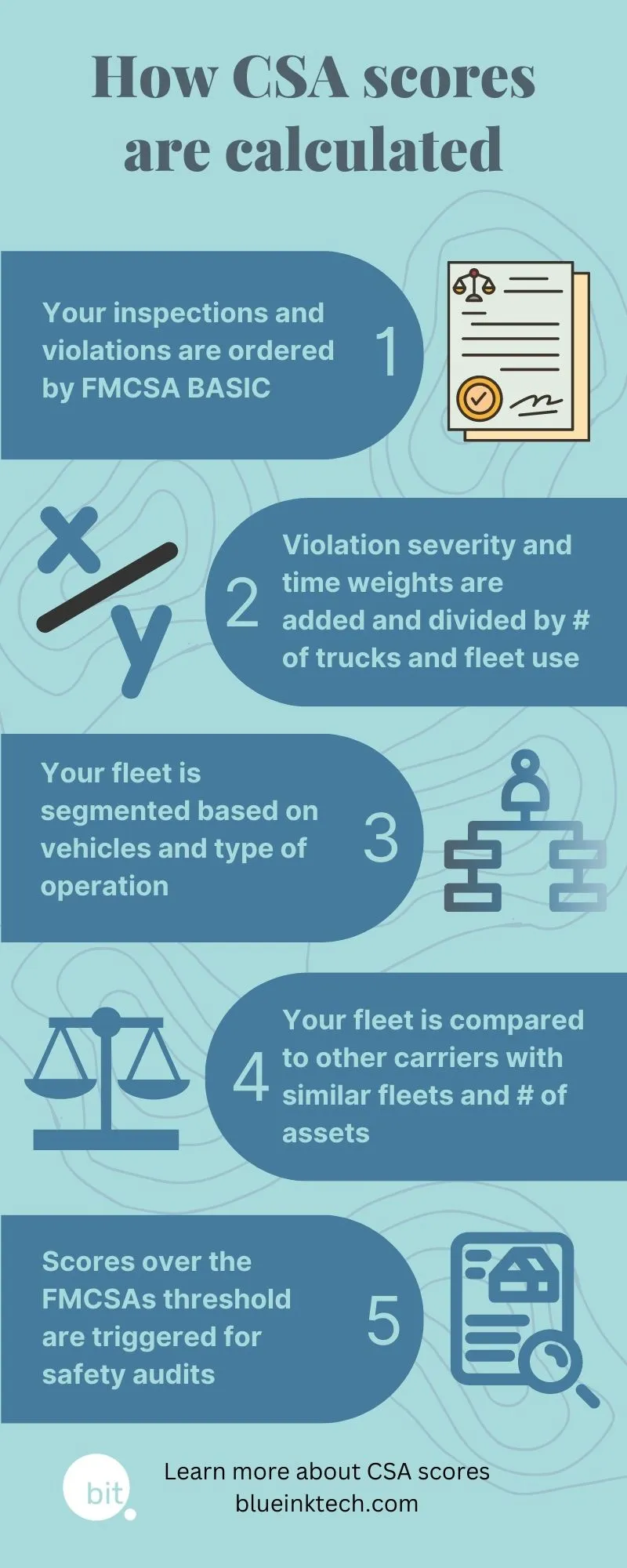CSA scores can be a factor in the success or failure of a carrier. They impact potential revenue, insurance rates, and even recruitment. So, what exactly is a CSA score? What goes into CSA score? How can a CSA score impact your business? And what exactly can you do to improve your CSA score?
What are CSA scores?
The FMCSA’s Compliance, Safety, and Accountability (CSA) program is designed with two purposes in mind: holding carriers responsible to safety standards and preventing accidents through proactive intervention.
This is done by calculating a score through the Safety Measurement System (SMS). SMS tracks and measures data from a carrier’s operations in the past two years to identify carriers at greater risk of accidents and violations. The score is assigned to your DOT and updates once a month.
The data used to calculate your score includes:
- Crash reports provided by states
- Violations found during roadside inspections
- Violations found during safety audits and investigations
How are CSA scores calculated?
Every imaginable safety-related violation is placed within a specific Behavioral Analysis and Safety Improvement Category or FMCSA BASIC.
There are seven BASICs:
- Unsafe Driving
- Driver Fitness
- Hours-of-Service Compliance
- Vehicle Maintenance
- Controlled Substances
- Crash Indicator
- Hazardous Materials Compliance
Your CSA score is based around how your company's safety performance compares to other carriers in the industry in these 7 categories. Your score is set on a 0-100 point scale with a lower score being good and higher score being bad.
The criteria that goes into your calculations are as follows:
- Severity weight of the violation you received
- The amount of time that has passed since you received the violation
- The number of power units (PUs) of your fleet
- The number of miles that you traveled based on your MCS-150 report
These items are taken into account and used to calculate your BASIC measure for the specific BASIC category your violations fall inside of. A BASIC calculation looks like this:

Time severity weight
The time severity of a violation depends on when the violation was received. The older the violation the less impact it has on your measure. The time weights are 1,2 and 3.
Violations that occurred in the last 6 months have a time weight of 3. Violations that occurred between 6 and 12 months have a time weight of 2 and violations older than 12 months have a time weight of 1. Violations older then 2 years will fall out of the calculations.
Violation severity weight
The severity weight of a violation is based on a 1-10 point scale with 1 being less sever and 10 being most sever. These points are set based on the crash risk of the violation.
For instance speeding 15 mph over the speed limit has a severity of 10, an improper lane change has a severity of 5 and failing to use hazard warning flashers has a severity of 1.
Average power units (PUs)
Average power units are used in part to account for each carrier’s level of exposure when calculating the BASIC measure. The number of owned, term-leased, and trip-leased power units (trucks, tractors, HM tank trucks, motor coaches, and school buses) contained in the Census data are used to calculate the PU totals.
The average power units for each carrier are calculated using the carrier’s current number of power units, the number of power units the carrier had six months ago,and the number of power units the carrier had 18 months ago. The average PU calculation is shown below:

Fleet utilization
The next part of the CSA score calculation factors in your fleets utilization over the 2 year period used to calculate your score. The metric used here is known a the utilization factor. This is the number of miles that you reported on your MCS-150 form divided by your average power units to get average vehicle miles traveled.
This calculation is done for every carrier, accounting for every violation under all of the 7 BASICS. Once all of the scores are computed then they are ranked highest to lowest and then the 0-100 point percentile is calculated for your company.
Segmentation of different fleets
The Unsafe Driving and Crash Indicator BASICs account for carrier differences by segmenting the carrier population into two groups based on the types of vehicles that they operate. This segmentation ensures that carriers with fundamentally different types of vehicles/operations are not compared to each other. The two segments are:
Combination or combination trucks/motor coach buses when these vehicle types make up 70% or more of the total PU types in a motor carrier’s fleet
Straight or straight trucks/other vehicles when these vehicle types make up more than 30% of the total PUs in a motor carrier’s fleet.
These separate groups make sure that carriers using class 7,8 trucks to haul freight do not get compared to smaller medium duty vehicles in the lower classes.
Intervention thresholds
The FMCSA has set an “intervention threshold” for each BASIC to help prioritize who receives intervention. Each BASIC is weighted by the highest crash risk, so the intervention thresholds are different for each category. When a carrier’s BASIC score is at or above the threshold, the likelihood of intervention grows.
 https://csa.fmcsa.dot.gov/documents/smsmethodology.pdf
https://csa.fmcsa.dot.gov/documents/smsmethodology.pdf
How do CSA scores impact a carrier?
- Increased intervention. The higher your score, the more likely you’ll receive warning letters, safety audits, roadside inspections, and in extreme cases, an out-of-service order.
- Revenue and profit. While Crash Indicator and Hazardous Materials Compliance BASICs are not public, the five other BASICs are. Shippers can easily look up a carrier’s CSA score and use it to determine who to hire for loads.
- Recruitment. If a carrier is unable to receive good loads and is dealing with the stress of intervention, it becomes difficult to keep drivers on the road.
- Insurance. Insurance companies often use CSA scores to evaluate a carrier’s risk profile and factor it into your premium and deductible.
How do I check my CSA score?
Carriers can look up their own CSA score and the CSA score of any drivers that they plan to hire from the FMCSA. It should be part of every carriers hiring process to check the CSA scores of all drivers before they bring them into their company.
Bad drivers can bring down a companies reputation and open them up to more scrutiny by the FMCSA. To view your own CSA score you can visit https://ai.fmcsa.dot.gov/SMS/ and login in using your USDOT# and PIN
Are there ways to improve my CSA scores?
- Improve your hiring process. The FMCSA’s PSP (Pre-Employment Screening Program) contains a driver’s crash and inspection data for the past five years and can help lower crash rate by 8% and driver out-of-service rates by 17%.
- Contest erroneous violations. Don’t be afraid to contest violations you think were wrongly assessed. DataQ allows you to report incorrect data and wrongful violations.
- Educate your drivers and reward good behavior. Teach your employees and drivers the importance of CSA scores and why it’s important to be trained in DOT compliance. Rewarding good maintenance, compliance, and record keeping helps lower CSA scores.
- Consider a good ELD provider. HOS violations are one of the most common violations. You can alleviate the risk of Hours-of-Service violations by implementing a reliable ELD service.
Keeping your CSA score in good standing requires diligence to safety standards. And improving it takes patience and changes. Either way, it’s important to keep an eye on your CSA score so you can keep your carrier and business running smoothly.


